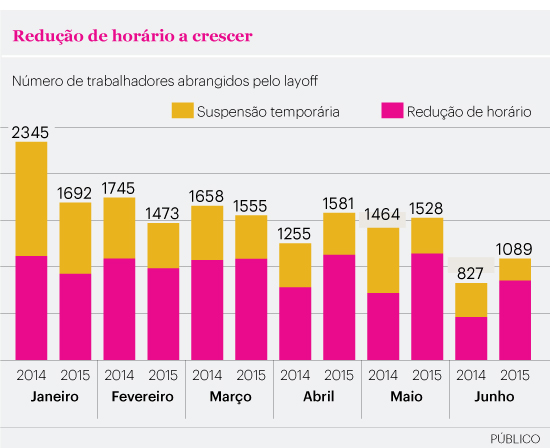Businesses who use the layoff are betting more on the cutting working hours to try to answer breaks the business. Looking at the data of the first half, it turns out that from March (inclusive), there was an increase in the number of workers on shorter working hours, framed in layoff , compared with the same months last year.
On the other hand, and according to data from the Social Security available through the Strategy Office and Ministry of Economy Studies, the total number of employees targeted by layoff (including those who have suffered a temporary suspension of contracts) also exceeded in the months of the last quarter, the numbers in the same period 2014.
There are fewer companies to resort this measure, but the difference in annual terms has been eroded as from the beginning of 2015. In January, there were 99 companies to resort to layoff , less than 59 in the same month last year. In April and May, the difference was less and less 30 29, respectively. And, according to data from Strategy and Research Office (GHG), there were 95 companies involved in Process layoff in June, only about nine than that recorded in same month of 2014.

On the other hand, there were over 262 workers involved in these processes, a total of 1089, which were broken down between 235 and 854 with temporary suspension with time reduction (an increase of 85% compared to the figures recorded a year ago). “It’s not the first time that it appears this situation where there are more workers with time reduction,” said the secretary general of the Confederation of Trade and Services of Portugal (CCP), Ana Vieira. For some companies, he says, “it makes sense that the activity be suspended, but that reduces the number of hours worked.” At the same time, believes that what is striking is “always we are talking about a small number of companies that resort to this mechanism.”
So, while recognizing that the of numbers layoff are far from the peak years of the economic crisis (in 2009 there were 423 companies to resort to this mechanism, covering a total of 19,278 workers) in practice this ” is always a figure that few companies use, “says Ana Vieira. “It makes sense that there, but it was worth it evaluate what can be improved and what are the requirements that discourage businesses in their use,” added the head of the CCP. The fact that there are situations in which “the Christmas bonus is paid, but not holiday the” is one of them explains.
Although the group of companies is restricted and that throughout the past year there have been annual reductions of 37% in the number of companies in layoff (344) and 40% in the number of workers who have been faced with payment situations with benefits layoff (4460), the numbers seem to indicate that this year the outlook may be less positive.
If the downward trend of the layoff that was noted particularly in the second half of 2014 “was awarded” the amendments to labor legislation, “which increased other forms of precariousness and facilitated dismissals “, the trend of increased use of this mechanism from December” suggests that something serious is going on with the economy, “argues Armando Faria, head of the CGTP. Even if there are alternatives that “could mitigate the effect of layoff “, if it is growing again, then it is because “there are serious problems regarding the economy,” he added.
The fact that there is a big difference between working time reduction regime and those with contract suspension in the first half of the year also shows that companies “have to work less rhythm and why something is wrong, “adds Armando Faria. The difference between the two types of layoff was particularly pronounced in May, when there were 1145 workers with reduced hours and 383 with suspended contracts.
The data provided by GEE not identify, however, the sectors that use more to this management strategy, which helps overcome a certain conjunctural moment of lack of demand (and not a more structural problem). Thus, you can not realize the problems they face, particularly if they are suffering impacts of the fall in exports to Angola (which fell 25% this year).
In 2009 , record year for use of the layoff , the automotive components industry was particularly affected, and many ended up resorting to collective redundancies. Faurecia, the Sodecia and Tyco were only a few cases that year jumped to the pages of newspapers. At present, the current scenario is different, guarantees the president of the Manufacturers Association for the Automotive Industry (AFIA), Tomás Moreira.
No comments:
Post a Comment